Pan-European Mapping of Underutilized Land for Bioenergy Production
Abstract
1. Introduction
2. Study Area and Data
2.1. Study Area
2.2. Data
2.2.1. Satellite Imagery
2.2.2. Reference Data for Training
- The limited spatial extent per observation: “The “point” (or basic unit of observation) is in fact a circle with a radius of 1.5 m corresponding to an identifiable point on an orthophoto. As we have not only homogeneous classes that we would like to observe, for example forests (forest definition requires observing a certain area to define the crown coverage or canopy of the trees) or orchards (which may consist in more than one tree species, etc.), the LUCAS observation framework also specifies an observation area, the “extended window of observation” which is the area defined by a 20 m radius around the point, for specific classes.” [1].
- The point grid was not the same for all surveys, thus sometimes, there is only land use information for a specific year (e.g., 2015), but no information about the land use before or after.
- Sometimes a shift in the location between the same points can be observed in two different surveys.
- The last survey was conducted in 2018; the classification is done using image time series data from 2015 to 2019.
- High Resolution Layers (HRL) Forest, Imperviousness, and Water and Wetness
- CORINE Land Cover (CLC) 2018 agriculture classes “Arable land” (21), “Permanent crops” (22), and “Pastures” (23).
2.2.3. Data for Masking Specific Areas
- Forest areas (HRL Forest): Forest areas are considered to be used land. Changing forests to other land use types is usually critical in terms of carbon balance [26] and was therefore avoided. Especially in Eastern Europe and former Soviet Union countries, young forests are growing on abandoned agricultural farmland [27,28]. The re-cultivation of these lands is a major issue of discussion [29,30]. However, since forest areas provide higher potential for carbon sequestration, we do not consider these areas as “underutilized land”.
- Settlement areas (HRL Imperviousness, Open Street Map (OSM), and CORINE land cover): Settlements belong to the category of used land.
- Water and Wetland areas (HRL Water and Wetness): In addition to excluding water bodies, wetland areas were removed for two reasons: first, due to limitations in drivability for mechanized growing of bioenergy crops, and second, due to the high natural value and biodiversity potential entailed in wetlands [31].
- Protected areas (Natura2000): Protected areas are removed totally, although the consortium is aware that crops used for energy might be allowed in some protected areas (e.g., outer zones of national parks). However, due to missing European-wide spatial separation between allowed and restricted zones, all areas are removed to avoid critical land competition.
- Steep slopes (>15° slope in Shuttle Radar Topography Mission digital elevation model (SRTM)): Steep slopes with inclinations larger than 15° are also removed because mechanized land cultivation is typically not feasible.
- Other not usable areas (CORINE land cover): Other not usable areas like beaches, bare rocks, or glaciers (CLC classes 331, 332 and 335) are also eliminated.
- Areas permanently used for agriculture (CORINE land cover): From the agriculturally used areas, most classes (CLC classes 221, 222, 223, 231, 241, 242, and 244) are removed. The annual crops in CORINE land cover (CLC classes 211, 212, and 213) are not removed in order to detect abandoned farmlands.
3. Methodology
3.1. Method for the Classification of Underutilized Land
- minimum
- maximum
- standard deviation
- percentiles (10 and 90)
3.2. Method for Validation of the Results
- (1)
- Reliability: if VHR data of less than three of the five years was available in Google Earth or if the interpretation could not be done due to bad quality or winter imagery, this attribute was flagged as “not reliable”, which means the point is not interpretable with a high confidence.
- (2)
- Borders: if the point was located within 30 m of the border between classes, the attribute was flagged as “borders”.
- (3)
- Small stripes: if a point was located in an area of small structures, mainly agricultural areas or gardens, with a minimum width of less than 30 m, the attribute was flagged as “small stripes”.
4. Results
5. Conclusions
Author Contributions
Funding
Institutional Review Board Statement
Informed Consent Statement
Data Availability Statement
Conflicts of Interest
References
- European Commission. Directive (EU) 2018/2001 of the European Parliament and of the Council of 11 December 2018 on the Promotion of the Use of Energy from Renewable Sources. Official Journal of the European Union, L328/82. Available online: https://eur-lex.europa.eu/legal-content/EN/TXT/PDF/?uri=CELEX:32018L2001 (accessed on 21 January 2021).
- Longato, D.; Gaglio, M.; Boschetti, M.; Gissi, E. Bioenergy and Ecosystem Services Trade-Offs and Synergies in Marginal Agricultural Lands: A Remote-Sensing-Based Assessment Method. J. Clean. Prod. 2019, 237, 117672. [Google Scholar] [CrossRef]
- Smeets, E.; Faaij, A.; Lewandowski, I.; Turkenburg, W. A Bottom-up Assessment and Review of Global Bio-Energy Potentials to 2050. Prog. Energy Combust. Sci. 2007, 33, 56–106. [Google Scholar] [CrossRef]
- Nijsen, M.; Smeets, E.; Stehfest, E.; Vuuren, D.P. An Evaluation of the Global Potential of Bioenergy Production on Degraded Lands. GCB Bioenergy 2012, 4, 130–147. [Google Scholar] [CrossRef]
- Robledo-Abad, C.; Althaus, H.-J.; Berndes, G.; Bolwig, S.; Corbera, E.; Creutzig, F.; Garcia-Ulloa, J.; Geddes, A.; Gregg, J.S.; Haberl, H.; et al. Bioenergy Production and Sustainable Development: Science Base for Policymaking Remains Limited. GCB Bioenergy 2017, 9, 541–556. [Google Scholar] [CrossRef] [PubMed]
- Humpenöder, F.; Popp, A.; Bodirsky, B.L.; Weindl, I.; Biewald, A.; Lotze-Campen, H.; Dietrich, J.P.; Klein, D.; Kreidenweis, U.; Müller, C.; et al. Large-Scale Bioenergy Production: How to Resolve Sustainability Trade-Offs? Environ. Res. Lett. 2018, 13, 024011. [Google Scholar] [CrossRef]
- Alcantara, C.; Kuemmerle, T.; Baumann, M.; Bragina, E.V.; Griffiths, P.; Hostert, P.; Knorn, J.; Müller, D.; Prishchepov, A.V.; Schierhorn, F.; et al. Mapping the Extent of Abandoned Farmland in Central and Eastern Europe Using MODIS Time Series Satellite Data. Environ. Res. Lett. 2013, 8, 035035. [Google Scholar] [CrossRef]
- Estel, S.; Kuemmerle, T.; Alcántara, C.; Levers, C.; Prishchepov, A.; Hostert, P. Mapping Farmland Abandonment and Recultivation across Europe Using MODIS NDVI Time Series. Remote Sens. Environ. 2015, 163, 312–325. [Google Scholar] [CrossRef]
- Estel, S. Mapping Cropland-Use Intensity across Europe Using MODIS NDVI Time Series. Environ. Res. Lett. 2016, 11, 024015. [Google Scholar] [CrossRef]
- Feranec, J.; Soukup, T.; Taff, G.; Stych, P.; Bičík, I. Overview of Changes in Land Use and Land Cover in Eastern Europe. In Land-Cover and Land-Use Changes in Eastern Europe after the Collapse of the Soviet Union in 1991; Springer: Cham, Switzerland, 2017; pp. 13–33. [Google Scholar]
- Löw, F.; Prishchepov, A.; Waldner, F.; Dubovyk, O.; Akramkhanov, A.; Biradar, C.; Lamers, J. Mapping Cropland Abandonment in the Aral Sea Basin with MODIS Time Series. Remote Sens. 2018, 10, 159. [Google Scholar] [CrossRef]
- Lesiv, M.; Schepaschenko, D.; Moltchanova, E.; Bun, R.; Dürauer, M.; Prishchepov, A.V.; Schierhorn, F.; Estel, S.; Kuemmerle, T.; Alcántara, C.; et al. Spatial Distribution of Arable and Abandoned Land across Former Soviet Union Countries. Sci. Data 2018, 5. [Google Scholar] [CrossRef]
- Lieskovský, J.; Bezák, P.; Špulerová, J.; Lieskovský, T.; Koleda, P.; Dobrovodská, M.; Bürgi, M.; Gimmi, U. The Abandonment of Traditional Agricultural Landscape in Slovakia—Analysis of Extent and Driving Forces. J. Rural Stud. 2015, 37, 75–84. [Google Scholar] [CrossRef]
- Szatmári, D.; Kopecka, M.; Feranec, J.; Goga, T. Abandoned Agricultural Land Mapping Using Sentinel-2a Data. In Proceedings of the 7th International Conference on Cartography and GIS, Sozopol, Bulgaria, 18–23 June 2018; Bandrova, T., Konečný, M., Eds.; 2018. Available online: https://www.researchgate.net/publication/325644850_ABANDONED_AGRICULTURAL_LAND_MAPPING_USING_SENTINEL-2A_DATA (accessed on 21 January 2021).
- Baumann, M.; Kuemmerle, T.; Elbakidze, M.; Ozdogan, M.; Radeloff, V.C.; Keuler, N.S.; Prishchepov, A.V.; Kruhlov, I.; Hostert, P. Patterns and Drivers of Post-Socialist Farmland Abandonment in Western Ukraine. Land Use Policy 2011, 28, 552–562. [Google Scholar] [CrossRef]
- Gorelick, N.; Hancher, M.; Dixon, M.; Ilyushchenko, S.; Thau, D.; Moore, R. Google Earth Engine: Planetary-Scale Geospatial Analysis for Everyone. Remote Sens. Environ. 2017, 202, 18–27. [Google Scholar] [CrossRef]
- ETC/BD. The Indicative Map of European Biogeographical Regions: Methodology and Development. 2006. Available online: https://www.google.at/url?sa=t&rct=j&q=&esrc=s&source=web&cd=&ved=2ahUKEwiS5b7b_azuAhWL-KQKHd8CAv4QFjABegQIAhAC&url=https%3A%2F%2Fwww.eea.europa.eu%2Fdata-and-maps%2Fdata%2Fbiogeographical-regions-europe-2005%2Fmethodology-description-pdf-format%2Fmethodology-description-pdf-format%2Fdownload&usg=AOvVaw1sSWT_9h8yBy36ULNiBgjI (accessed on 21 January 2021).
- European Environmental Agency (EEA). Biogeographical Regions. Available online: https://www.eea.europa.eu/data-and-maps/data/biogeographical-regions-europe-3#tab-metadata (accessed on 16 December 2020).
- Joshi, N.; Baumann, M.; Ehammer, A.; Fensholt, R.; Grogan, K.; Hostert, P.; Jepsen, M.; Kuemmerle, T.; Meyfroidt, P.; Mitchard, E.; et al. A Review of the Application of Optical and Radar Remote Sensing Data Fusion to Land Use Mapping and Monitoring. Remote Sens. 2016, 8, 70. [Google Scholar] [CrossRef]
- Roy, D.P.; Wulder, M.A.; Loveland, T.R.; Woodcock, C.; Allen, R.G.; Anderson, M.C.; Helder, D.; Irons, J.R.; Johnson, D.M.; Kennedy, R.; et al. Landsat-8: Science and Product Vision for Terrestrial Global Change Research. Remote Sens. Environ. 2014, 145, 154–172. [Google Scholar] [CrossRef]
- U.S. Geological Survey. Landsat 8 Collection 1 (C1) Land Surface Reflectance Code (LaSRC) Product Guide 2020. Available online: https://www.usgs.gov/media/files/landsat-8-collection-1-land-surface-reflectance-code-product-guide (accessed on 21 January 2021).
- Wulder, M.A.; Masek, J.G.; Cohen, W.B.; Loveland, T.R.; Woodcock, C.E. Opening the Archive: How Free Data Has Enabled the Science and Monitoring Promise of Landsat. Remote Sens. Environ. 2012, 122, 2–10. [Google Scholar] [CrossRef]
- Aschbacher, J.; Milagro-Pérez, M.P. The European Earth Monitoring (GMES) Programme: Status and Perspectives. Remote Sens. Environ. 2012, 120, 3–8. [Google Scholar] [CrossRef]
- Drusch, M.; Del Bello, U.; Carlier, S.; Colin, O.; Fernandez, V.; Gascon, F.; Hoersch, B.; Isola, C.; Laberinti, P.; Martimort, P.; et al. Sentinel-2: ESA’s Optical High-Resolution Mission for GMES Operational Services. Remote Sens. Environ. 2012, 120, 25–36. [Google Scholar] [CrossRef]
- Friedl, P. Derivation of Glaciological Parameters from Time Series of Multi-Mission Remote Sensing Data—Applications to Glaciers in Antarctica and the Karakoram. Ph.D. Thesis, Friedrich-Alexander-University of Erlangen-Nürnberg, Erlangen, Germany, 2020. [Google Scholar]
- Houghton, R.A.; Nassikas, A.A. Global and Regional Fluxes of Carbon from Land Use and Land Cover Change 1850–2015. Glob. Biogeochem. Cycles 2017, 31, 456–472. [Google Scholar] [CrossRef]
- Kuemmerle, T.; Olofsson, P.; Chaskovskyy, O.; Baumann, M.; Ostapowicz, K.; Woodcock, C.E.; Houghton, R.A.; Hostert, P.; Keeton, W.S.; Radeloff, V.C. Post-Soviet Farmland Abandonment, Forest Recovery, and Carbon Sequestration in Western Ukraine: Carbon Sequestration on Abandoned Farmland. Glob. Chang. Biol. 2011, 17, 1335–1349. [Google Scholar] [CrossRef]
- Lesiv, M.; Shvidenko, A.; Schepaschenko, D.; See, L.; Fritz, S. A Spatial Assessment of the Forest Carbon Budget for Ukraine. Mitig. Adapt. Strateg. Glob. Chang. 2019, 24, 985–1006. [Google Scholar] [CrossRef]
- Smaliychuk, A.; Müller, D.; Prishchepov, A.V.; Levers, C.; Kruhlov, I.; Kuemmerle, T. Recultivation of Abandoned Agricultural Lands in Ukraine: Patterns and Drivers. Glob. Environ. Chang. 2016, 38, 70–81. [Google Scholar] [CrossRef]
- Rhemtulla, J.M.; Mladenoff, D.J.; Clayton, M.K. Historical Forest Baselines Reveal Potential for Continued Carbon Sequestration. Proc. Natl. Acad. Sci. USA 2009, 106, 6082–6087. [Google Scholar] [CrossRef] [PubMed]
- Russi, D.; ten Brink, P.; Farmer, A.; Badura, T.; Coates, D.; Förster, J.; Kumar, R.; Davidson, N. The Economics of Ecosystems and Biodiversity for Water and Wetlands. IEEP Lond. Bruss. 2013, 78. Available online: https://www.cbd.int/financial/values/g-ecowaterwetlands-teeb.pdf (accessed on 21 January 2021).
- Myroniuk, V.; Kutia, M.; Sarkissian, A.J.; Bilous, A.; Liu, S. Regional-Scale Forest Mapping over Fragmented Landscapes Using Global Forest Products and Landsat Time Series Classification. Remote Sens. 2020, 12, 187. [Google Scholar] [CrossRef]
- Foga, S.; Scaramuzza, P.L.; Guo, S.; Zhu, Z.; Dilley, R.D.; Beckmann, T.; Schmidt, G.L.; Dwyer, J.L.; Joseph Hughes, M.; Laue, B. Cloud Detection Algorithm Comparison and Validation for Operational Landsat Data Products. Remote Sens. Environ. 2017, 194, 379–390. [Google Scholar] [CrossRef]
- Wu, C.; Niu, Z.; Tang, Q.; Huang, W. Estimating Chlorophyll Content from Hyperspectral Vegetation Indices: Modeling and Validation. Agric. For. Meteorol. 2008, 148, 1230–1241. [Google Scholar] [CrossRef]
- Clevers, J.G.P.W.; Gitelson, A.A. Remote Estimation of Crop and Grass Chlorophyll and Nitrogen Content Using Red-Edge Bands on Sentinel-2 and -3. Int. J. Appl. Earth Obs. Geoinf. 2013, 23, 344–351. [Google Scholar] [CrossRef]
- Sonobe, R.; Yamaya, Y.; Tani, H.; Wang, X.; Kobayashi, N.; Mochizuki, K. Crop Classification from Sentinel-2-Derived Vegetation Indices Using Ensemble Learning. J. Appl. Remote Sens. 2018, 12, 1. [Google Scholar] [CrossRef]
- Sharifi, A. Remotely Sensed Vegetation Indices for Crop Nutrition Mapping. J. Sci. Food Agric. 2020, 100, 5191–5196. [Google Scholar] [CrossRef]
- Mercier, A.; Betbeder, J.; Baudry, J.; Le Roux, V.; Spicher, F.; Lacoux, J.; Roger, D.; Hubert-Moy, L. Evaluation of Sentinel-1 & 2 Time Series for Predicting Wheat and Rapeseed Phenological Stages. ISPRS J. Photogramm. Remote Sens. 2020, 163, 231–256. [Google Scholar]
- Daughtry, C.S.T.; Walthall, C.L.; Kim, M.S.; de Colstoun, E.B.; McMurtrey, J.E. Estimating Corn Leaf Chlorophyll Concentration from Leaf and Canopy Reflectance. Remote Sens. Environ. 2000, 74, 229–239. [Google Scholar] [CrossRef]
- Kim, M.S. The Use of Narrow Spectral Bands for Improving Remote Sensing Estimation of Fractionally Absorbed Photosynthetically Active Radiation (FAPAR). Master’s Thesis, Department of Geography, University of Maryland, College Park, MD, USA, 1994. [Google Scholar]
- Qi, J.; Chehbouni, A.; Huete, A.R.; Kerr, Y.H.; Sorooshian, S. A Modified Soil Adjusted Vegetation Index. Remote Sens. Environ. 1994, 48, 119–126. [Google Scholar] [CrossRef]
- Liaw, A.; Wiener, M. Classification and Regression by RandomForest. R News 2002, 2, 18–22. [Google Scholar]
- Horning, N. Random Forests: An Algorithm for Image Classification and Generation of Continuous Fields Data Sets. In Proceedings of the International Conference on Geoinformatics for Spatial Infrastructure Development in Earth and Allied Sciences, Osaka, Japan, 9–11 December 2010. [Google Scholar]
- Li, T.; Ni, B.; Wu, X.; Gao, Q.; Li, Q.; Sun, D. On Random Hyper-Class Random Forest for Visual Classification. Neurocomputing 2016, 172, 281–289. [Google Scholar] [CrossRef]
- Ali, J.; Khan, R.; Ahmad, N.; Maqsood, I. Random Forests and Decision Trees. Int. J. Comput. Sci. Issues IJCSI 2012, 9, 272. [Google Scholar]
- Grinand, C.; Rakotomalala, F.; Gond, V.; Vaudry, R.; Bernoux, M.; Vieilledent, G. Estimating Deforestation in Tropical Humid and Dry Forests in Madagascar from 2000 to 2010 Using Multi-Date Landsat Satellite Images and the Random Forests Classifier. Remote Sens. Environ. 2013, 139, 68–80. [Google Scholar] [CrossRef]
- Gómez, C.; White, J.C.; Wulder, M.A. Optical Remotely Sensed Time Series Data for Land Cover Classification: A Review. ISPRS J. Photogramm. Remote Sens. 2016, 116, 55–72. [Google Scholar] [CrossRef]
- Dalponte, M.; Ørka, H.O.; Gobakken, T.; Gianelle, D.; Næsset, E. Tree Species Classification in Boreal Forests with Hyperspectral Data. IEEE Trans. Geosci. Remote Sens. 2012, 51, 2632–2645. [Google Scholar] [CrossRef]
- Mellor, A.; Boukir, S.; Haywood, A.; Jones, S. Exploring Issues of Training Data Imbalance and Mislabelling on Random Forest Performance for Large Area Land Cover Classification Using the Ensemble Margin. ISPRS J. Photogramm. Remote Sens. 2015, 105, 155–168. [Google Scholar] [CrossRef]
- Olofsson, P.; Foody, G.M.; Herold, M.; Stehman, S.V.; Woodcock, C.E.; Wulder, M.A. Good Practices for Estimating Area and Assessing Accuracy of Land Change. Remote Sens. Environ. 2014, 148, 42–57. [Google Scholar] [CrossRef]
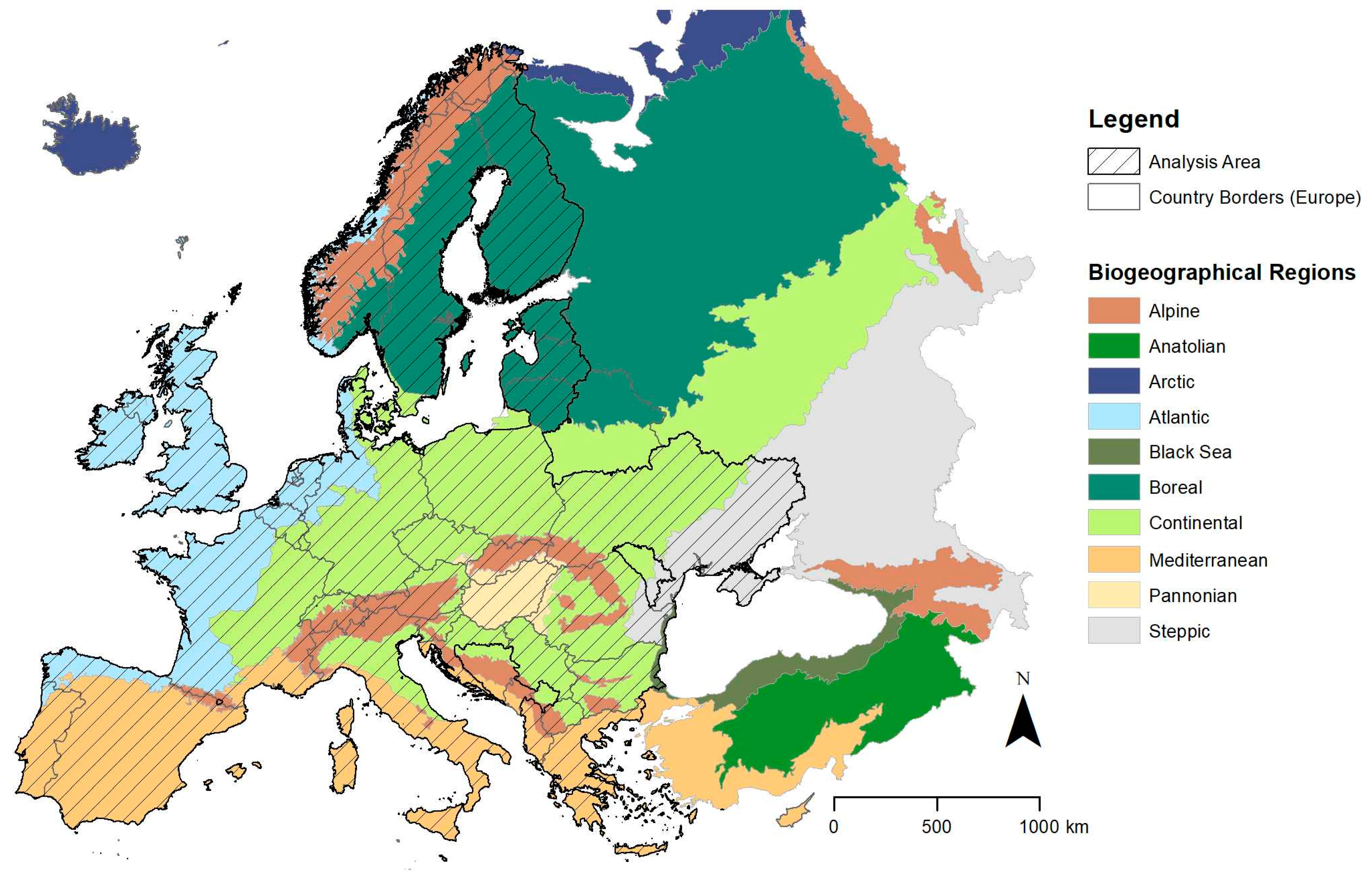
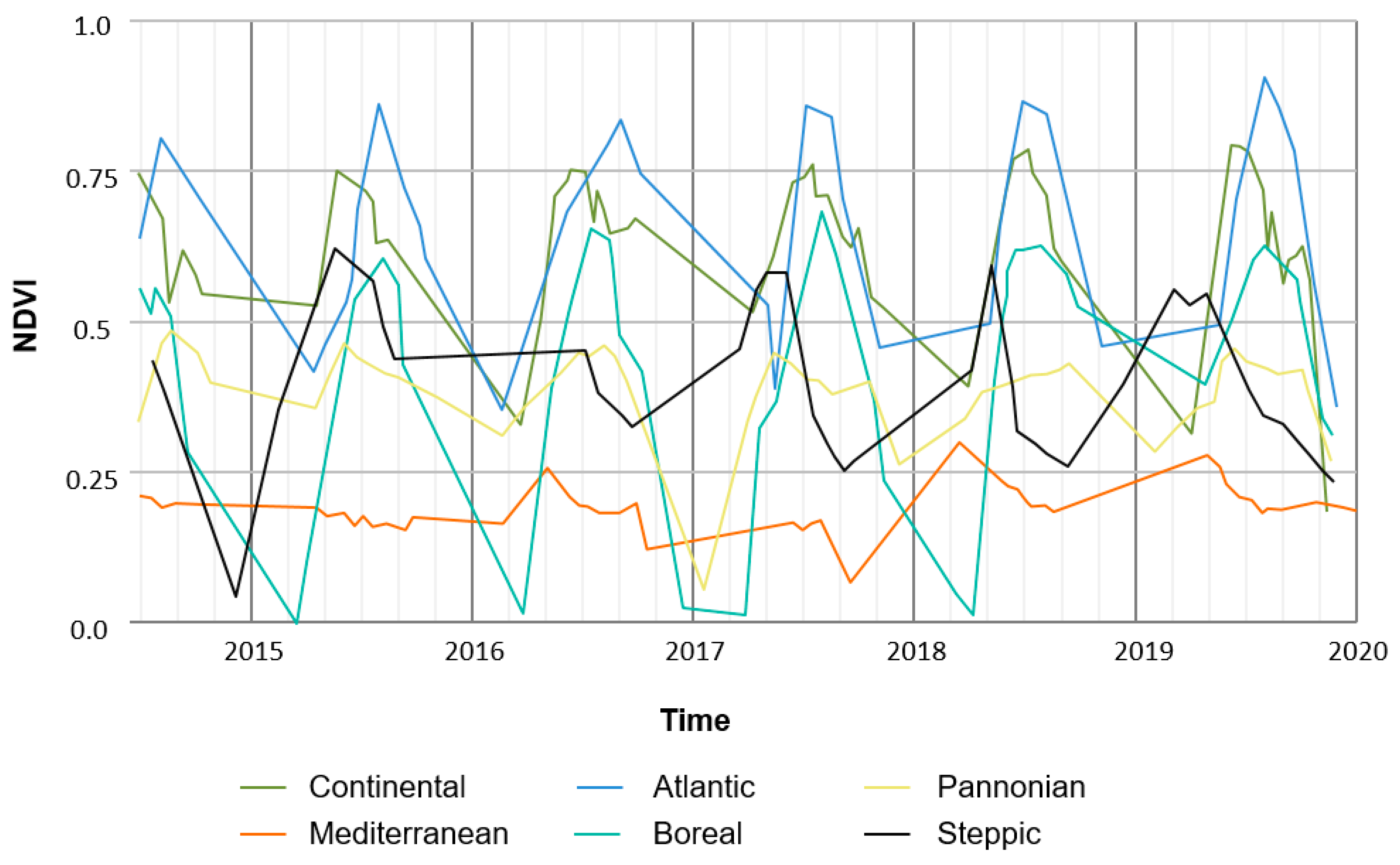
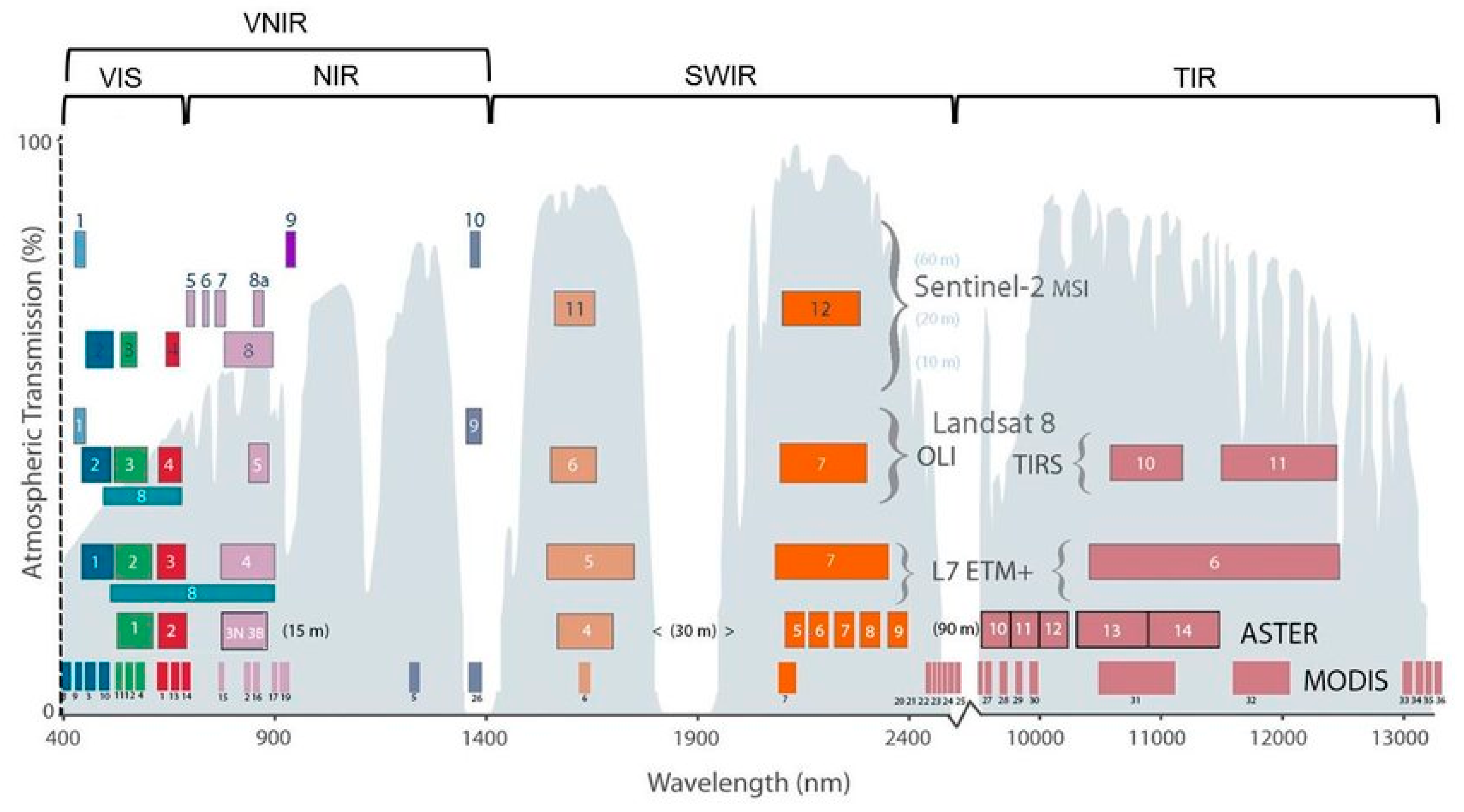
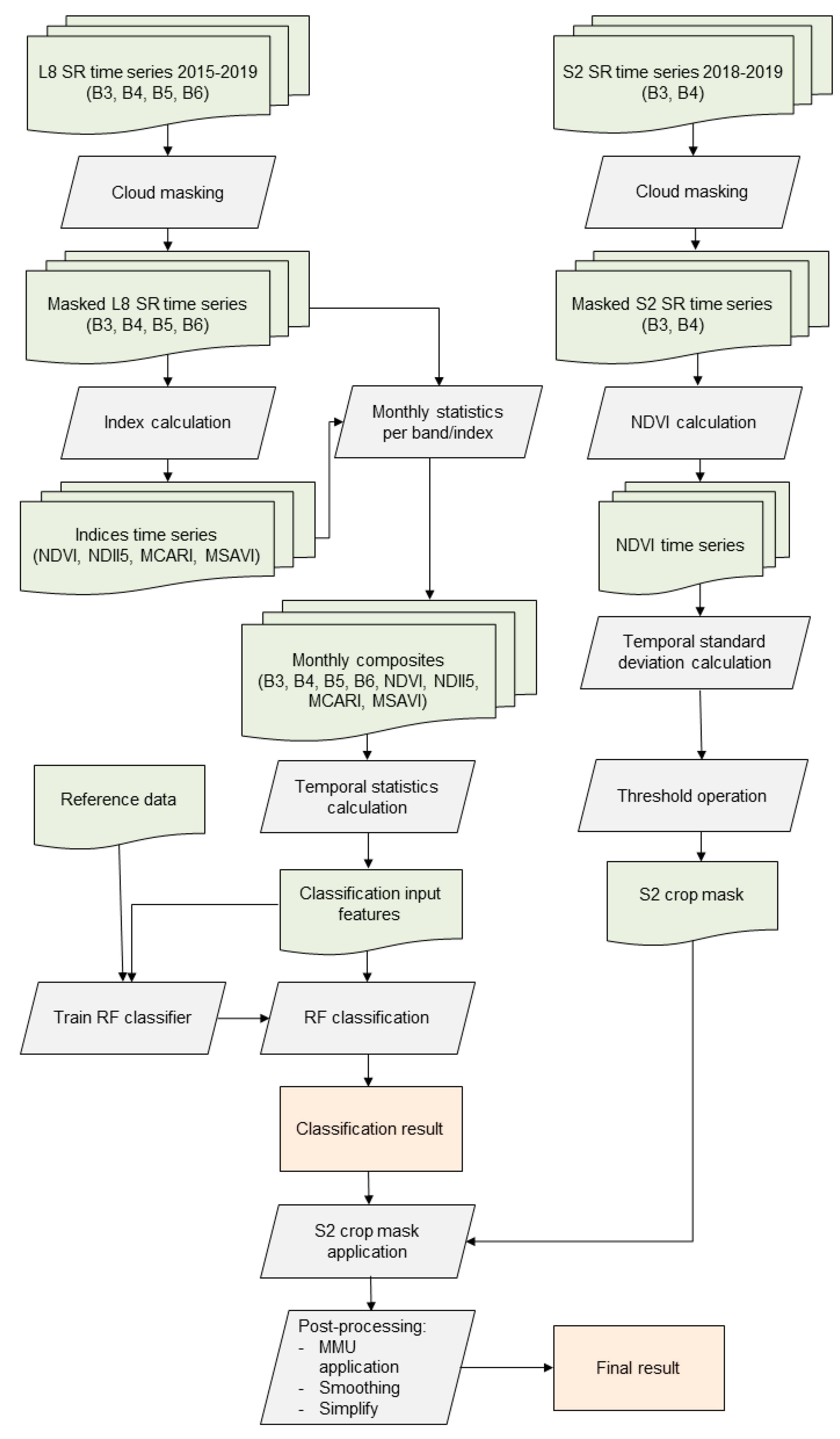

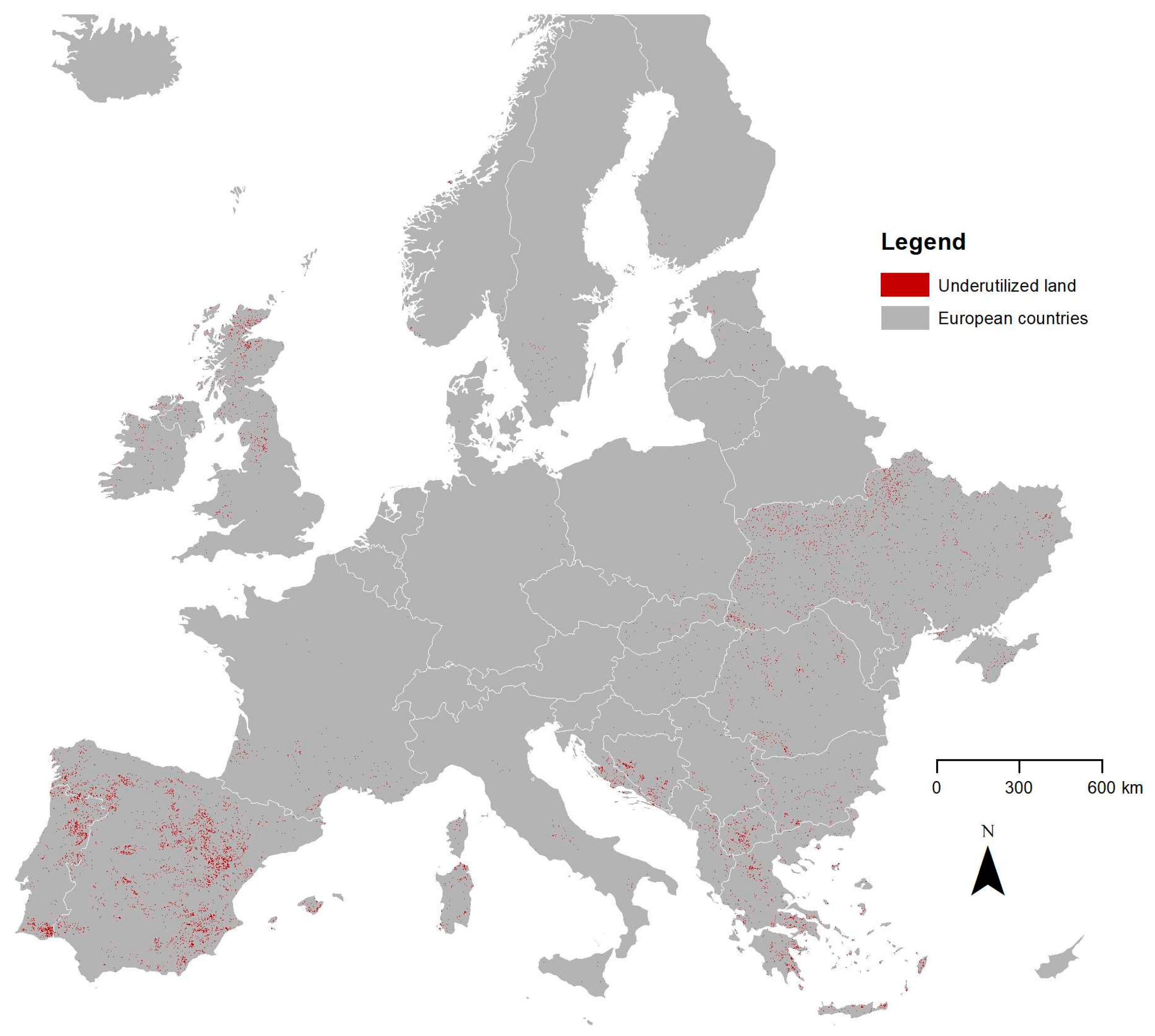
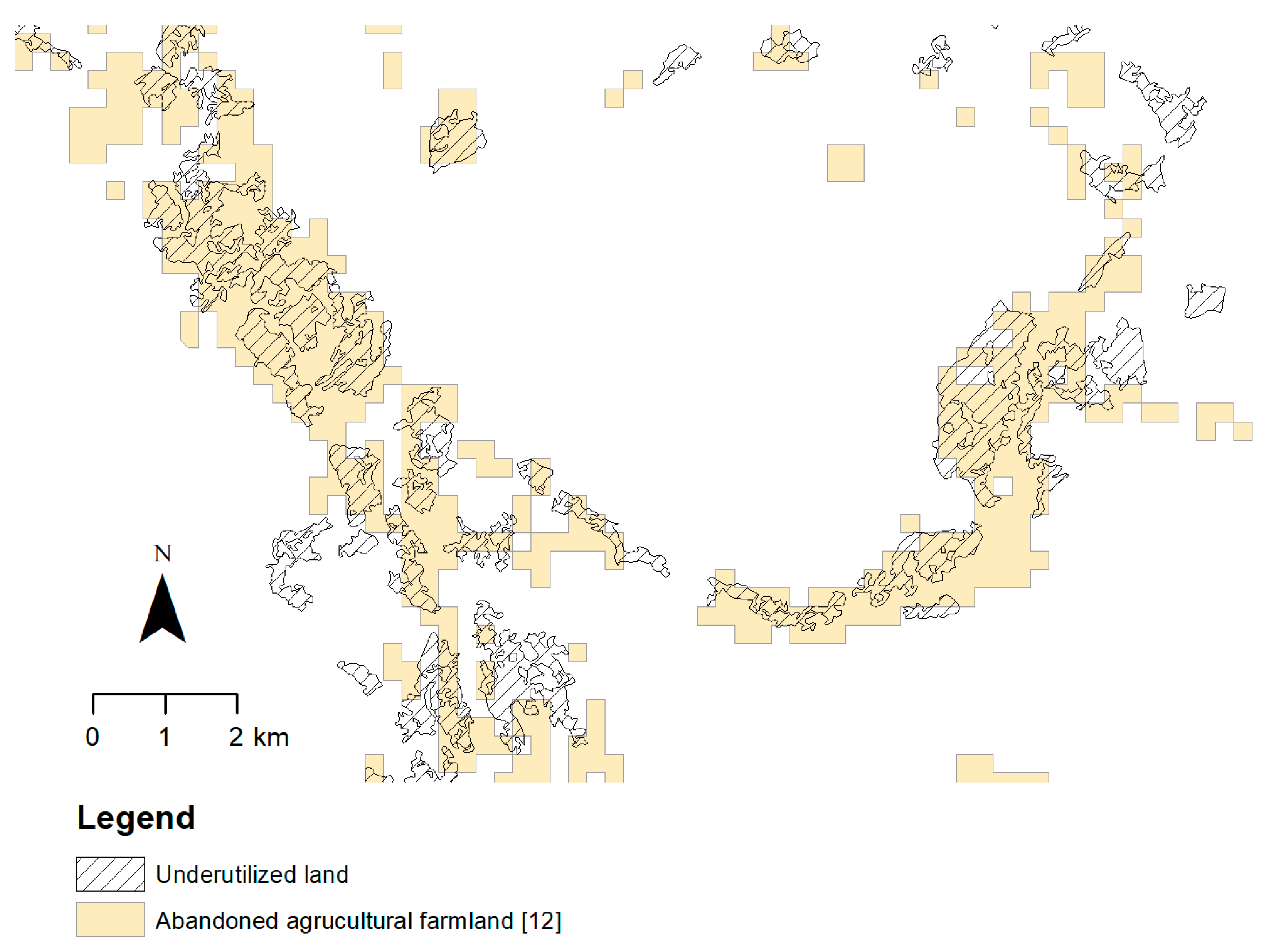
| Biogeographical Region | Study Area (ha) | Elimination Mask (ha) | Area of Interest (ha) |
|---|---|---|---|
| Alpine | 63,815,477 | 50,898,030 | 12,917,447 |
| Atlantic | 86,135,597 | 53,133,180 | 33,002,417 |
| Boreal | 89,317,815 | 60,034,485 | 29,283,330 |
| Continental | 173,990,564 | 93,346,118 | 80,644,446 |
| Mediterranean | 92,181,777 | 59,869,101 | 32,312,676 |
| Pannonian | 12,901,241 | 5,121,331 | 7,779,910 |
| Steppic | 28,226,727 | 6,233,216 | 21,993,511 |
| Overall | 546,569,198 | 328,635,461 | 217,933,737 |
| Biogeographical Region | Area of Interest (Ha) | UU Area (Ha) | UU from AOI (%) | Average Size per UU Patch (Ha) | Average Compactness Index per UU Patch |
|---|---|---|---|---|---|
| Alpine | 12,917,447 | 356,913 | 2.76 | 39.2 | 0.2102 |
| Atlantic | 33,002,417 | 634,985 | 1.92 | 33.7 | 0.2218 |
| Boreal | 29,283,330 | 61,408 | 0.21 | 28.5 | 0.2766 |
| Continental | 80,644,446 | 1,336,876 | 1.66 | 29.9 | 0.1875 |
| Mediterranean | 32,312,676 | 2,579,935 | 7.98 | 49.6 | 0.1940 |
| Pannonian | 7,779,910 | 139,010 | 1.79 | 26.4 | 0.2287 |
| Steppic | 21,993,511 | 200,392 | 0.91 | 23.2 | 0.2036 |
| Overall | 217,933,737 | 5,309,519 | 2.44 | 32.9 | 0.2175 |
| Biogeographical Region | Utilized | Underutilized | Total |
|---|---|---|---|
| Alpine | 111 | 50 * | 161 |
| Atlantic | 286 | 74 | 360 |
| Boreal | 258 | 50 * | 308 |
| Continental | 700 | 155 | 855 |
| Mediterranean | 262 | 300 | 562 |
| Pannonian | 67 | 50 * | 117 |
| Steppic | 92 | 50 * | 142 |
| Overall | 1876 | 729 | 2605 |
| Biogeographical Region | OA (%) (CI) | U: OE (%) (CI) | U: CE (%) (CI) | UU: OE (%) (CI) | UU: CE (%) (CI) |
|---|---|---|---|---|---|
| Alpine | 62.16 (8.82) | 1.17 (0.65) | 37.84 (9.06) | 95.55 (1.12) | 38.00 (13.59) |
| Atlantic | 91.43 (2.31) | 0.37 (0.12) | 8.42 (2.33) | 92.24 (2.24) | 32.43 (10.57) |
| Boreal | 90.62 (3.61) | 0.06 (0.03) | 9.69 (3.62) | 98.38 (0.63) | 24.00 (11.96) |
| Continental | 90.62 (2.10) | 0.52 (0.13) | 9.06 (2.14) | 88.08 (2.65) | 27.74 (7.07) |
| Mediterranean | 70.08 (5.19) | 1.74 (0.50) | 31.30 (5.63) | 80.75 (2.87) | 14.00 (3.93) |
| Pannonian | 98.17 (2.88) | 0.40 (0.21) | 1.49 (2.93) | 51.61 (48.78) | 22.00 (11.60) |
| Steppic | 85.28 (4.96) | 0.32 (0.14) | 14.58 (5.01) | 95.77 (1.53) | 30.00 (12.83) |
| Overall | 85.52 (1.55) | 0.66 (1.55) | 14.27 (1.50) | 88.06 (1.32) | 22.77 (3.05) |
Publisher’s Note: MDPI stays neutral with regard to jurisdictional claims in published maps and institutional affiliations. |
© 2021 by the authors. Licensee MDPI, Basel, Switzerland. This article is an open access article distributed under the terms and conditions of the Creative Commons Attribution (CC BY) license (http://creativecommons.org/licenses/by/4.0/).
Share and Cite
Hirschmugl, M.; Sobe, C.; Khawaja, C.; Janssen, R.; Traverso, L. Pan-European Mapping of Underutilized Land for Bioenergy Production. Land 2021, 10, 102. https://doi.org/10.3390/land10020102
Hirschmugl M, Sobe C, Khawaja C, Janssen R, Traverso L. Pan-European Mapping of Underutilized Land for Bioenergy Production. Land. 2021; 10(2):102. https://doi.org/10.3390/land10020102
Chicago/Turabian StyleHirschmugl, Manuela, Carina Sobe, Cosette Khawaja, Rainer Janssen, and Lorenzo Traverso. 2021. "Pan-European Mapping of Underutilized Land for Bioenergy Production" Land 10, no. 2: 102. https://doi.org/10.3390/land10020102
APA StyleHirschmugl, M., Sobe, C., Khawaja, C., Janssen, R., & Traverso, L. (2021). Pan-European Mapping of Underutilized Land for Bioenergy Production. Land, 10(2), 102. https://doi.org/10.3390/land10020102







